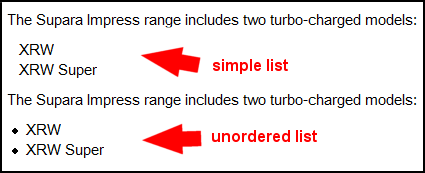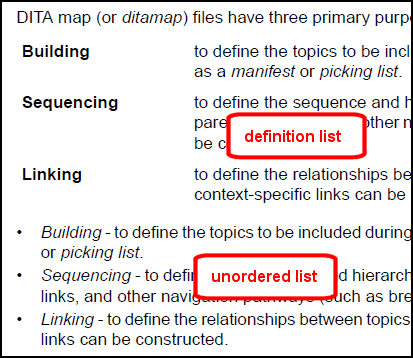Types of lists
There are four semantically-distinct general purpose list types in DITA, each of which is typically rendered differently in the output.
- Simple Lists
- A simple list (sl) is one where the items in the list are short phrases, and where the order of items in the list is not important. The list is usually rendered with each item on a separate line, without bullets or numbers.
- Bulleted (unordered) Lists
- An unordered list (ul) is one where the order of items in the list is not important. The list is usually rendered with bullets against each list item. The items are typically blocks of text.
- Numbered (ordered) Lists
- An ordered list (ol) is one where the order of items is critical to the meaning. The list is usually rendered with sequential numbers against the list items.
- Definition Lists
- A definition list (dl) is one comprising a set of terms and corresponding definitions. The list is usually rendered with definitions indented from the term and on the next line, or with definitions indented from the term on the same line as the term.
These lists are semantically distinct, although the difference between a simple list and an unordered list is minor. Some processors may output simple lists as inline lists, rather than block lists (separate lines per item).
List types are not interchangeable; the content of the list will determine which list type is appropriate for it. Choose a list type by considering the nature of the list, not by the way you think the list will be rendered in the output.


Although simple lists are technically valid inside ordered, unordered and definition list items, you should avoid nesting simple lists inside other lists.
DITA includes some other special purpose list structures, such as parameter list (parml) and choice list (choices).